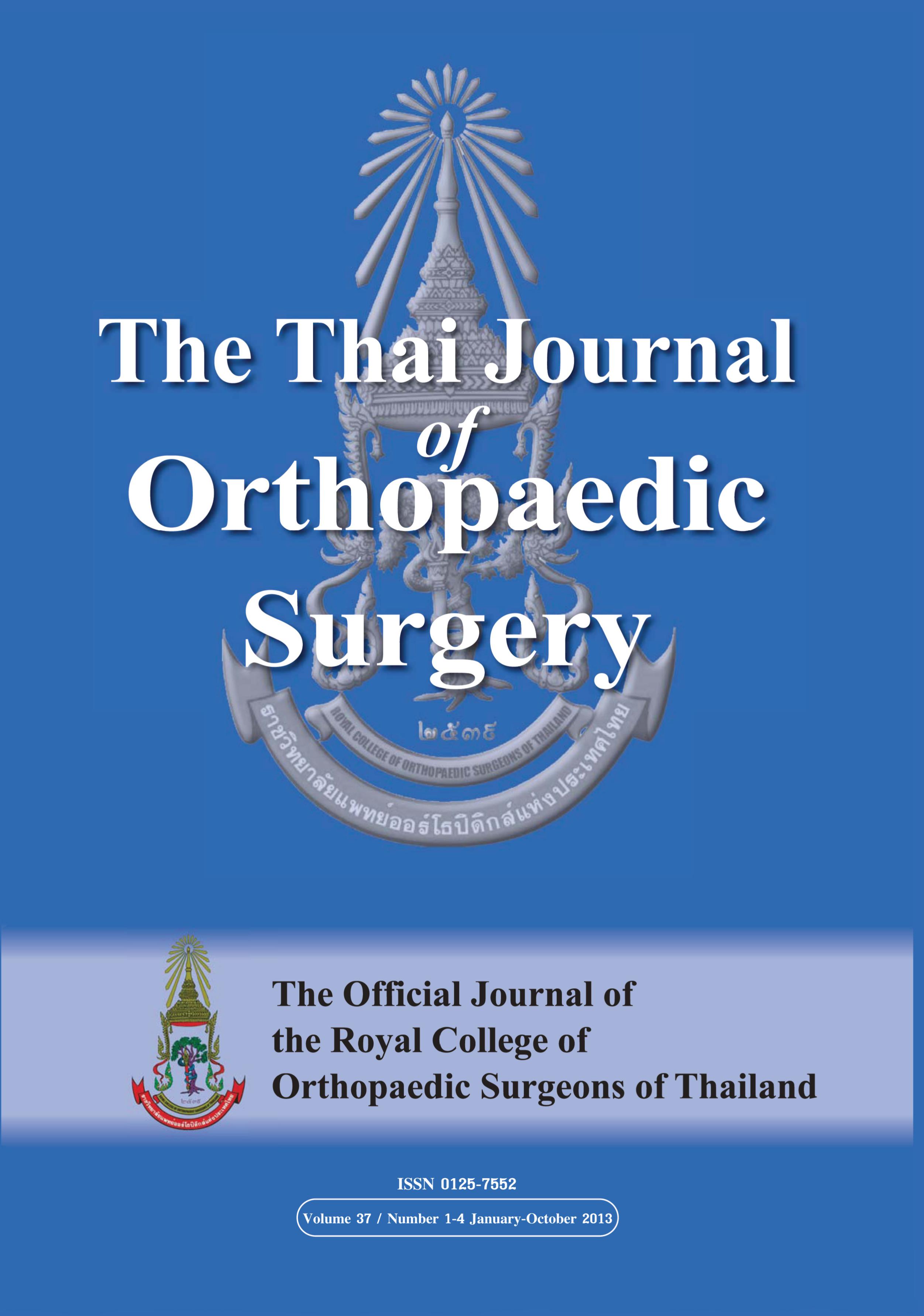Prevalence and Conditions Associated with Neuropathic Pain in Orthopaedic Patients of Bangkok Metropolitan Administration General Hospital
Main Article Content
Abstract
Purpose: Neuropathic pain results from a primary lesion or dysfunction in the nervous system. Diagnosing neuropathic pain can be difficult, however, this condition is common in clinical practice. There is limited information on the prevalence of neuropathic pain in the Thai orthopaedic departments. The objective of this study was to investigate the prevalence of neuropathic pain and association factors in the orthopaedic out-patient clinic, Bangkok Metropolitan Administration (BMA) Hospital.
Methods: A cross-sectional study of 400 patients attending the orthopaedic out-patient clinic, BMA hospital was conducted. The Thai DN4 questionnaire was used for the diagnosis of neuropathic pain. Main diagnosis and co-morbidities were recorded. Descriptive statistics were used to provide the basic information. The Chi-square test was applied for the association and binary logistic regression was used for multivariate analysis.
Results: The prevalence of neuropathic pain was 22.3%. The missed diagnosis rate was found to be 16.2%. There was statistically significant association between neuropathic pain and nerve entrapment.The most common symptoms used in practice by physicians for the diagnosis of neuropathic pain were reported as tingling (92.1%), pins and needles (78.7%) and numbness (70.8%) in this study.
Conclusion: This study demonstrated a need to increase awareness of neuropathic pain in orthopaedic out-patient clinics. Health care providers should promote the DN4 questionnaire to diagnose neuropathic pain in clinical practice.
Article Details
References
2. Hansson P. Neuropathic pain: clinical characteristics and diagnostic workup. Eur J Pain 2002; 6: 47-50.
3. Jensen TS, Gottrup H, Sindrup SH, Bach FW. The clinical picture of neuropathic pain. Eur J Pharmacol 2001; 429: 1-11.
4. Galer BS, Dworkin RH. A clinical guide to neuropathic pain. Minneapolis(MN): McGraw-Hill; 2000: 4-6.
5. Dworkin RH. An overview of neuropathic pain: syndromes, symptoms, signs, and several mechanisms. Clin J Pain 2002; 18: 343-9.
6. Dworkin RH, Backonja M, Rowbotham MC, Allen RR, Argoff CR, Bennet GJ, et al. Advances in neuropathic pain: diagnosis, mechanisms, and treatment recommendations. Arch Neurol 2003; 60: 1524-34.
7. Stevens PE, Dibble SL, Miaskowski C. Prevalence characteristics and impact of postmastectomy pain syndrome: an investigation of women’s experiences. Pain 1995; 61: 61-8.
8. Jensen MP, Chodroff MJ, Dworkin RH. The impact of neuropathic pain on health-related quality of life: review and implications. Neurology 2007; 68: 1178-82.
9. Meyer-Rosberg K, Kwanstrom A, Kinnman E, Gordh T, Nordfos LO, Kristofferson A. Peripheral neuropathic pain- a multidimensional burden for patients. Eur J Pain 2001; 5: 379-89.
10. Berger A, Dukes EM, Oster G. Clinical characteristics and economic costs of patients with painful neuropathic disorders. J Pain 2004; 5: 143-9.
11. Bouhassir, Attal N, Alchaar H, Boureau F, Bruxelle J, Cunin G, et al. Comparison of pain syndromes associated with nervous or somatic lesion and development of new neuropathic pain diagnostic questionnaire(DN4). Pain 2005; 114: 29-36.
12. Chaudakshetrin P, Prateepavanich P, Chira-Adisai W, Tassanawipas W, Leechavengvongs S, Kitisomprayoonkul W. Cross-cultural adaption to the Thai language of the neuropathic pain diagnostic questionnaire (DN4). J Med Asso Thai 2007; 90: 1860-65.
13. Torrance N, Smith BH, Bennett MI, Lee AJ. The epidemiology of chronic pain of predominantly neuropathic origin. Results from a general population survey. J Pain 2006; 7: 281-9.
14. Chaudakshetrin P. A neuropathic pain survey at Siriraj Pain Clinic. J Med Assoc Thai 2006; 89: 354-61.
15. Grond S, Radbruch L, Meuser T, Sabatowski R, Loich G, Lehmann KA. Assessment and treatment of neuropathic cancer pain following WHO guidelines. Pain 1999; 79: 15-20.
16. Dubinsky RM, Kabbani H, El-Chami Z, Boutwell C, Ali H. Practice parameter: treatment of postherpatic neuralgia: an evidence-based report of the Quality Standards Subcommittee of the American Academy of Neurology. Neurology 2004; 63: 959-65.
17. Werhgen L, Budh CN, Hulting C, Molander C. Neuropathic pain after traumatic spinal cord injury- relations gender, spinal level, completeness, and age at the time of injury. Spinal Cord 2004; 42: 665-73
18. Werhgen L, Hutling C, Molander C. The prevalence of neuropathic pain after non-traumatic spinal cord lesion. Spinal Cord 2007; 45: 609-15.
19. Stevens PE, Dibble SL, Miaskowski C. Prevalence characteristics and impact of postmastectomy pain syndrome: an investigation of women’s experiences. Pain 1995; 61: 61-8.
20. Jensen TS, Backonja MM, Hernandez Jimenez S, Tesfaye S, Valensi P, Ziegler D. New perspectives on the management of diabetic peripheral neuropathic pain. Diab Vasc Dis Res 2006; 3: 108-19.


